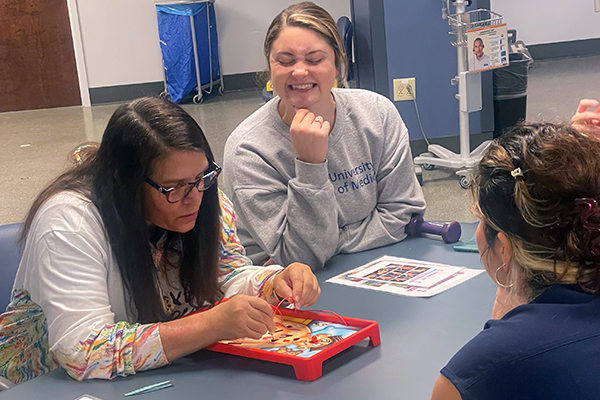Inside the Class: Enabling Occupation Skills IV

Enabling Occupation Skills IV, or OTD 603, is a pivotal course within Duke University's Occupational Therapy Doctorate (OTD) program. It is designed to enhance students' theoretical understanding and foster hands-on experience with real-world applications. As part of the curriculum, students collaborate with community client volunteers, engaging in assessments and intervention planning that directly impact client outcomes.
This course, second-year OTD students explore the person factors influencing motor function, sensation, control, and cognition. These factors are outlined in the Occupational Therapy Practice Framework (AOTA, 2020), which defines them as “health conditions that may affect the person’s occupations but are not the primary concern of the occupational therapy encounter.” By honing these skills, students gain deeper insight into how impairments can disrupt an individual’s engagement in meaningful activities.
Throughout the semester, students develop the competency to assess person factors such as range of motion, motor control, balance, sensation, and cognition. In the early weeks, students learn how to administer and interpret multiple assessments, helping them understand the comprehensive nature of occupational performance disruptions. These assessments provide critical data to design individualized intervention plans to improve clients’ occupational performance and re-engagement in meaningful activities.

Later in the course, the focus shifts to intervention design. Students learn to select therapeutic approaches to address impairments in motor function, cognition, and other person factors to enable engagement in occupation. By integrating knowledge from prior coursework, they begin to develop holistic intervention strategies that reflect the complexities of real-world client needs.
A defining feature of OTD 603 is its team-based approach, which emphasizes collaboration between students, faculty, and community volunteers. The course is led by a dynamic team of instructors, including MaryBeth Gallagher, PhD, OTR/L, BCMH, and Lucy Tamberrino, OTD, OTR/L, with additional support from a lab coordinator and three teaching assistants (TAs). Students benefit from the TAs’ clinical expertise, which provides valuable insights and practical perspectives on the challenges and nuances of occupational therapy.
According to student Hannah Bailey, the course provides a unique opportunity to learn from the team of instructors: “I enjoyed how the course connected us with TAs who are experienced occupational therapists,” she shared. The hands-on learning environment helps bridge the gap between theoretical instruction and practical application.

As the semester progresses, students put their skills into practice by working directly with community client volunteers who could benefit from occupational therapy. The students conduct assessments, collect data, and design interventions tailored to the volunteers' unique needs. This process culminates in a follow-up session two weeks later, where students implement their designed interventions.

Alicia Qiao, a student in the course, shared her excitement about applying her learning in a real-world context: “One of my favorite moments was administering one of the assessments we had learned about and practiced in class. Using the skills we learned with someone who could benefit and reflect was exciting. I feel like it was a moment when I could see so much of our preparation and learning come together.”
The course emphasizes skills, teamwork, and professional collaboration. Students are required to document their assessments and interventions, reflecting on their experiences in a collaborative team environment. These reports evaluate student progress and encourage peer reflection on how effective teamwork can improve client outcomes.

Reflecting on the experience, Hannah expressed how rewarding it was to work with her peers and observe the immediate impact of their efforts: “The most impactful moment for me was being able to carry out a neuro-occupational therapy intervention with my peers. We could see our positive impact on a client after just one session!”
This focus on collaboration not only enriches students’ learning but also aligns with the values of the occupational therapy profession, which emphasizes client-centered care and interdisciplinary teamwork. As Dr. Gallagher noted, the community clients’ enthusiasm for the program speaks to its success: “The most rewarding part of this class is watching the students engage with community client volunteers. They combine all their learning to enable engagement in an occupation that makes a difference to an individual and their family and ultimately impacts their health and wellbeing. I know this because the community client volunteers love the Duke OTD students, and they keep coming back!”
